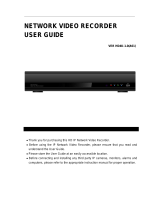
34 35
3.3 BACKUP
This NVR supports backing up files from the hard drive to both an external USB storage device as well
as over a network. Network downloads are covered in the Remote Monitoring Guide.
The Backup menu is located in the Functions
section of the Main menu.
The Backup window will display any connected
devices along with available space and status. If
you have a device connected to the USB port on
the front of the NVR and it does not appear, press
the Detect button. If it still does not appear, then
use a different USB device.
PICTURE 3-16
PICTURE 3-17
PICTURE 3-18
BACKUP
1 M 01-24-12 10:01:02 01-24-12 10:02:14 1701
1 M 01-24-12 10:06:56 01-24-12 10:18:23 21483
1 M 01-24-12 14:32:18 01-24-12 14:58:36 45842
1 M 01-25-12 06:56:12 01-25-12 07:14:16 38249
1 M 01-25-12 23:19:01 01-25-12 23:48:13 56921
1 M 01-27-12 03:04:54 01-27-12 03:07:52 2309
1 M 01-27-12 03:11:43 01-27-12 03:14:27 2217
1 M 01-27-12 08:06:07 01-27-12 08:53:09 32181
1 M 01-29-12 01:39:19 01-27-12 01:43:06 2101
1 M 01-29-12 02:30:36 01-27-12 02:36:36 2412
20
1
2
3
4
5
6
7
8
9
10
Start
AddRemove01 - 24 - 2012 10 : 01 : 02
Onekey Backup
CH Type Start Time End Time Size (KB)
Space Required / Space Remaining: 227.83 MB/972.52 MB
Page Up Page Down Select/Cancel backup device or file.
sdb(USB DISK)
All
Selected Device
Type
Start Time
End Time
1
Channel
DAV
File Format
02 - 13 - 2012 19 : 06 : 06
If you need to clear space on your external drive, you can use the Erase button. This will delete ALL files
on that device.
Once an external USB device is detected, pressing
the Backup button will open a new window
allowing you to select which files to back up. You
can select by channel, start and end times, as well
as which type of event; regular recording, alarm,
motion detection or all of them.
Only files with a check mark in front of them will be
backed up. You can deselect whichever files you
choose or select them all by selecting the box at
the top of the list.
NOTE! External USB hard drives used for backing up data will need to be
in the FAT32 format. Most new drives will need to be reformatted before use
with this DVR. Formatting instructions are provided at the end of this chapter.
Once you have selected the files, press Start
to begin the download. A progress bar will be
displayed showing estimated time remaining.
During the download, the Start button will change
to Stop. You can stop the process at any time by
pressing the button again.
You can also right-click out of the menu once the
file transfer has begun to go on to other activities
without cancelling the download.
BACKUP
1 M 01-24-12 10:01:02 01-24-12 10:02:14 1701
1 M 01-24-12 10:06:56 01-24-12 10:18:23 21483
1 M 01-24-12 14:32:18 01-24-12 14:58:36 45842
1 M 01-25-12 06:56:12 01-25-12 07:14:16 38249
1 M 01-25-12 23:19:01 01-25-12 23:48:13 56921
1 M 01-27-12 03:04:54 01-27-12 03:07:52 2309
1 M 01-27-12 03:11:43 01-27-12 03:14:27 2217
1 M 01-27-12 08:06:07 01-27-12 08:53:09 32181
1 M 01-29-12 01:39:19 01-27-12 01:43:06 2101
1 M 01-29-12 02:30:36 01-27-12 02:36:36 2412
20
1
2
3
4
5
6
7
8
9
10
Stop
AddRemove01 - 24 - 2012 10 : 01 : 02
Onekey Backup
CH Type Start Time End Time Size (KB)
Remaining time 0:6:44
Page Up Page Down Select/Cancel backup device or file.
sdb(USB DISK)
All
Selected Device
Type
Start Time
End Time
1
Channel
DAV
File Format
02 - 13 - 2012 19 : 06 : 06
PICTURE 3-19
PICTURE 3-20
The files will be saved with the following naming format:
SN_CH(channel number)_TYPE_TIME(Year, Month, Date, Hour, Minute, Second)
Therefore, a file shown on the DVR as being a regular record (R), being recorded on 01/04/11 starting at
2:00:00 would have a file name of:
1_01_R_010411020000.dav
The Year Date Month format is the same as you have set in the General interface. The .DAT files can be
played back or converted to .AVI format using the software included on the CD accompanying this NVR.
FORMATTING A USB DRIVE IN FAT32
To format a USB flash drive with FAT32, plug it into a PC running Windows XP or later. Go to My
Computer to locate the drive’s icon. Right click on it and select Format in the list of available options.
Select FAT32 and check the box marked Quick Format before clicking Start.
For USB drives over 32GB in size, you should use a FAT32 format utility such as those available through
CNET.com.
On a Macintosh computer, you will need to reformat the USB flash drive using the Disk Utility app
located in the Utilities folder within the Applications folder. Connect your drive to a USB port on the Mac
and it should appear in the list on the left of the window.
Select your drive from the list, making sure that it is highlighted before proceeding.
In OSX 10.6, you can set the format to MS-DOS
(FAT) in the Erase tab. In OSX 10.7, you will use
the Partition tab.
Click the Apply or Erase button, depending on
your system, to reformat the USB drive
IMPORTANT! Reformatting a drive will erase ALL data on the drive!





















